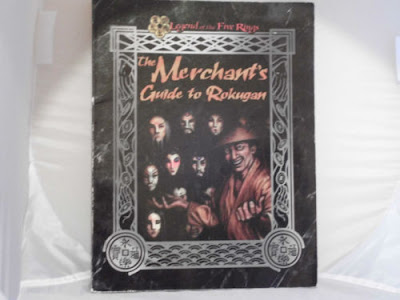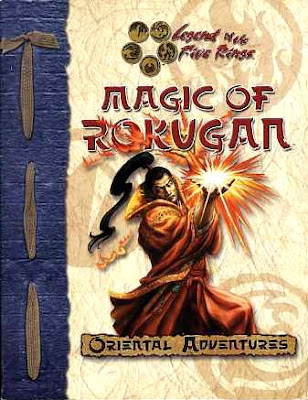
Image unrelated, except in that it amuses me that apparently WotC has decided that October is going to be Kara-Tur month too. So this is the cover of this month's Dragon "
Magazine", used entirely without their permission, but I assume they'll like the free advertising.
This is what I sent my player's yesterday, again most of it comes from module OA1: Swords of the Daimyo by David "Zeb" Cook and a lot of it was already typed up by Fabian from
Bladesharp on his OA website
Adventures in Kozakura, I just edited it for my campaign and reformatted it a little. I actually kind of wish, just a little, that I was waiting to start my new game until Fabian was done converting all of the Oriental Adventures classes to Labyrinth Lord, but just a little. Thanks for all your help Fabian!
-------------------------------------------------------------------------------------
Given the stunning failure of last years participants in my AD&D OA campaign to put an end to the Black Temple's shenanigans, I have created an alternate beginning timeline for the new campaign that includes the last aborted TPK ridden Oriental Adventures sessions. Instead of being stopped before they grew too powerful, the Black Temple grew to be a threat to the entire empire of Kozakura and a huge force of allied good aligned Samurai, Sohei, Shukenja and Wu Jen were forced to gather to put an end to the threat. This allied army battled the Evil army of the Black Temple and it's hordes of undead, humanoid and other planar minions and defeated them in an epic battle forcing them back to the Black Temple itself where they were sealed inside by mighty magical wards, wards that seem to be weakening now...
Now onto the nitty gritty stuff that everyone who lives in or around Miyama would know; I give you all "The Native's Guide to Miyama Province"; enjoy.
Religion-
In Miyama, as in all of Kozakura, there are two principal religions—the Way of Enlightenment, and the Eight Million Gods. The Way of Enlightenment is divided into several schools while the Eight Million Gods is split into many separate shrines. While different schools (or shrines) may hold essentially similar beliefs, the exact methods of worship, deities, and outward manifestations may be radically different.
Within each school or shrine, there are two groups of worshipers. The first group is more or less devoted to that particular school or shrine. This includes the Priests, Monks, Shukenja, Sohei, and devout worshipers of the group. These people do not entertain or practice the beliefs of other schools or shrines. The second group of worshipers, those who practice the rituals of more than one school or shrine, are far more common. This group includes the majority of the common people. They make offerings to one or more of the Eight Million Gods at planting time, pray for their departed according to the rituals of the Way of Enlightenment, and make donations and offerings to temples of both religions.
Korobokuru deities are all animal spirits. Many of their heroes have been elevated to half-animalistic demi-gods.
Miyama Province- Geography & Politics-
Miyama Province is located in the very center of Kozakura. It is the strategic key to controlling Shinkoku (the main island) and Kozakura as a whole. The province is divided into two main sections—the Northern Plain and the Southern Plain. Running through the middle of the province are the wooded peaks and ridges of the Kurisammyaku (Chestnut Mountains). Twisting through the hills and mountains, fast-rushing streams have cut narrow valleys. Most of these valleys are choked with the forests that carpet the mountain slopes. Some slopes have been cleared for farming.
Like the imperial government, the government of Miyama is a confusing, factional affair. The power struggles at the top between the shikken, shogun, and imperial line are reflected in the official posts and appointments made in Miyama. Each faction has some representative within the province. The top two positions in Miyama are the shugo-daimyo and the kokushu, or provincial governor. The shugo-daimyo is appointed to the province by the shogunal authorities. The kokushu is the imperial representative. Each of these has a number of minor officials under him. In addition, there are the samurai jito of the many estates (shoen) found throughout the province
The Social Order-
The Niwa FamilyAs noted before, the Niwa hold most of the land, the position of shugo-daimyo, and several of the shugodai posts. In addition, a number of the lesser family members hold jito positions on the largest shoen in Miyama. The Niwa family is the most powerfulin Miyama. Its efforts are aimed at retaining that power and perhaps some day conquering their neighbors.
The Hori FamilyThe Hori are a branch of the Niwa family, founded 32 years ago. The Hori hold posts of shugodai and shugo-matadai within Miyama. They control Hori Castle on the Northern Plain. They have less property than the Niwa, but act as jito on many Niwa shoen. Today, all members of the Hori family are distantly related to the Niwa. Thus the Hori are part of the Niwa family council, advising on major family decisions. The fate of the Hori is closely connected to that of the Niwa. The Hori hope to someday acquire control of the Niwa family, either through marriage or might of arms.
The Igi Family
As mokudai, the Igi have managed to gain control over several shoen of public (imperial) land. The Igi have been especially lax in making the payments to the emperor and the distant nobles who hold manager and protector rights. Although these nobles have filed many complaints with the shogun, little action has been taken. The Igi make certain the shogun and the shugo-dai both receive their proper payments, perhaps ensuring their neutrality in the matter of property rights.
The Igi are working hard to convert public land into private shoen, installing their own zussho wherever possible.
The Tsu Family
Once a powerful court family, the Tsu now retain only a limited presence in Miyama. Although they hold the title of kokushu, the Tsu have left most affairs in the hands of the Igi. Once they were
greater and more powerful than the Igi; now the situation is reversed. The Tsu are now considered an ally family of the Igi. They have only a few possessions in Miyama and these are carefully controlled by the Igi.
The Samurai Families
In addition to the four principal families listed above, there are a number of smaller samurai households. Most of these are retainers of one of the four listed above. They are either unrelated to the main family or only very distantly related. Those in the service of one of the main families are listed below.
Niwa-Matsue, Ishii, Naoki, Kishimoto, Sato, Mushakoji, Nogami, Watanabe
Hori- Daidoji, Kadokawa, Fukuda, Ooka, Kuroda, Maeda
Igi- Inoue, Ebisawa, Koda, Nogami
Tsu- Kato, Sakai, Ikeda
The above taken from OA1:Swords of the Daimyo by David "Zeb" Cook (copyright 1986 TSR) used without permission.
Names & Language-
Most characters should all choose as much as possible real world Japanese names; I shall do my best to ensure that NPCs are likewise named. I have printed out a list of Japanese names and their meanings for you to choose from. The 3rd edition D&D Oriental Adventures book has a list of Korobokuru names that should do nicely for them, and I have several lists for Barbarian names available as well. Spirit Folk and Hengeyokai have Human names. Where I use vocabulary and real world descriptive names from Japanese for things, please forgive any inaccuracies in precise usage, as I do not actually speak Japanese and ascribe it to Kara-Tur being a fantasy world!
Available Starting Languages-
Kozakuran (all characters receive this for free instead of Common)
Wa-an (characters can understand this language with about 65% comprehension)
Kao te Shou (spoken in the empire of Shou Lung)
Korobokuru (free to Korobokuru)
Trade Tongue (mostly used by merchants and sailors)
Koryo
Han (ancient root language of Koryo, Wa-an, and Kozakuran - used by scholars)
T'u Lung (similar to Kao te Shou, but dialects are very different - spoken in the empire of T'u Lung)
Barbarians will also start with the language of their tribe for free.
All of this being said, in my opinion most characters should actually save the proficiency slots, most Kozakurans never learn a second language unless they are scholars or merchants.

























